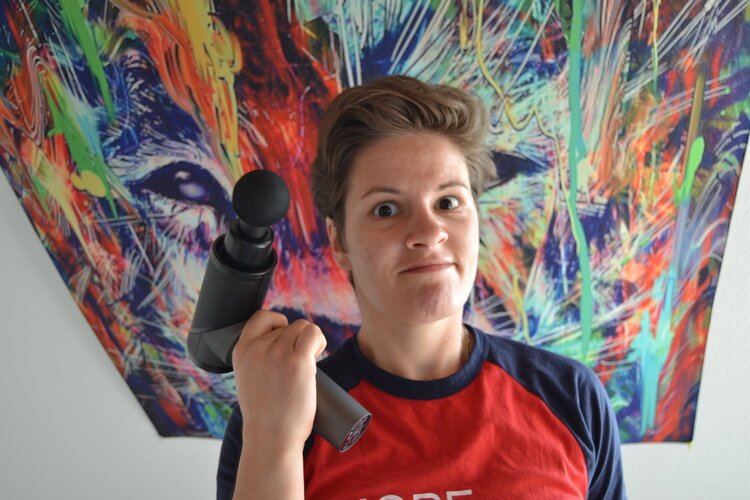Foam Rollers: Friend or Foe?
It’s time for confession. I’ll start.
I own a massage gun, a number of lacrosse balls, and an extra-hard “foam” roll that I cut from a spare PVC pipe in college. I use most of them regularly, almost always just before training, and they all give me that delicious “good pain” feeling.
But the scientist in me would never take a marketing claim as a data-support fact without looking into it first, and I would certainly never recommend any products or methods to my athletes, coaches, or colleagues that I hadn’t tested myself and checked into the research about.
Come with me on my adventure of good pain, blood flow, and how the heck fascia even works.
—————
PICKING APART SCIENCE VS. MARKETING.
If you are new to White Lion’s content or services, let me introduce you to one of our favorite sayings:
Good science wins. Good marketing sells.
Translation:
We prioritize methods that are backed by empirical research and our ever-advancing understanding of the human body over anecdotes, broad statements, and marketing claims.
Where do we draw the line of difference?
Think about the following: our knowledge of the brain, the body, of movement and performance has been developed over literal centuries of scientific exploration. And, while we have made serious advances from the days before we knew germs existed, for example, there are very rarely any new findings that absolutely smack us down off our feet and brutally overthrow our understanding of the human body or how to train.
Sure, we often have to make adjustments. We adapt. We find new ways to train that implement new knowledge. But the application of the science (think: training, recovery, mental skills, etc.) stays similar to it’s previous form and specific to its context.
That’s why, anytime you see a broad, sweeping claim about a new method, finding, or tool being able to help everyone, being newly discovered or ahead of its time, it’s probably just really good, shock-value marketing. General solutions rarely exist.
GREAT. LET’S TALK ABOUT FOAM ROLLING!
When the foam roller came out, the claims were, at best… general.
It loosens the knots in your muscles!
It gets rid of DOMS/muscle soreness!
It flattens out/releases your fascia!
It triggers lymphatic drainage!
It serves as a self-massage and self-chiropractic tool!
Those are some pretty big promises. And, even as a fan of self-myofascial release (called “SMR”; that is what foam rolling does), I was mad skeptical of literally all of those claims.
That just isn’t how the human body’s physiology works.
Fascia is a “filler”, a protective sheet of connective tissue that separate muscles and organs from each other inside the body. In the case of SMR specifically, foam rolling allegedly addresses the sheet of fascia, called the epimysium, that surrounds the body’s skeletal muscles. Inside of that bundle, of course, there are further layers of connective tissue, namely the perimysium and endomysium respectively.
While fascia do function as a protective shield around the muscle in this case, it is also a connector; fascia plays a large role in skeletal muscles acting as a synergistic system that works together, not alone. Fascia also adapts and changes with high-intensity training and performance, as it is partially responsible for the load-bearing capacity (strength, range of motion, and force absorption) of the muscles beneath it.
With a fairly robust physiology education under my belt, I dove into the research. Approximately 20 studies per year since 2014 have been published on foam rolling specifically, ranging from studying its impact on patients in ACL recovery or suffering from osteoarthritis to testing its performance benefits with healthy professional athletes before, during, and after training.
THE DOS AND DO NOTS.
While I am sure you did not click on this article for a high school AP Biology-style review, it is necessary to know the basics of human physiology to understand why these SMR claims were worth being wary of and researching.
And, without further ado, let’s get into what you came here for: The Dos and Do Nots of Foam Rolling.
DO NOTs:
Foam rolling and other SMR techniques do not, according to current research findings:
…change muscle hardness
…change fascicle length
…change, release, or flatten fascial structure
….provide any structural changes
…enhance or impair strength, speed, or jump performance
DOs:
However, not all is lost. Current studies do support that SMR can:
increase blood flow to a specific area (this may very indirectly promote recovery, but we need more studies to start speaking on that)
acutely increase flexibility and joint range of motion (ROM) for about ~10 minutes after SMR
lessen the experience of pain, soreness, or general discomfort temporarily
be more beneficial in warmups than static stretching protocols, which may impair performance
The Breakdown:
Did anything in either of these lists surprise you?
What did not surprise me was learning that SMR protocols, whether foam rolling, massage guns, or lacrosse balls, change absolutely nothing about our internal structures, especially not our fascia; there is nothing that we know about human physiology that strongly supports fascia “cramping”, “knotting up”, or “getting stuck”. There is also, at best, extremely weak evidence that SMR could even impact our muscles or tendons.
Example: when working in field sports, track and field, or distance running, it is common occurrence to hear the phrase “I’m going to roll out my IT band”. Boom - stick a foam roller under the outside of the leg and go to town. In reality, the IT band is so thick and strong that, to achieve a structural change, I would first have to attach your IT band to two Ford F150 pickup trucks and drive them in opposite directions. No, SMR will do nothing there.
What did surprise me is that SMR brings significant acute changes to flexibility, ROM, and the experience of pain. However, this makes sense, as our nervous system plays a primary role in all three of these factors. When we roll or trigger-point, we essentially send our nervous system a cue through the muscle (our muscles are activated through special units called “motor nerves”) to relax that area. This, in turn, allows us to feel less tight, less in-pain, and achieve greater flexibility.
However, as with all good news, there is a catch: these effects are only temporary, lasting around 10 minutes. That is why we always need to “get on the foam roll again”. The changes do not stick, because we did not actually change any structures.
TIPS FOR USING & NOT LOSING.
As you (hopefully) already read, there are indeed benefits to SMR protocols; this is not an article to dash anyone’s hopes and dreams about using their beloved foam roller.
It is, though, important to know what we are doing and why, so that we can optimize for what we want. If you believe your foam roller or your physical therapist’s magic massage hands will help your tight hamstrings, yet you are stiff as a board again 30 minutes later and have to get back on the foam roll or desperately await another appointment with your physio two days later, you are not meeting your own needs or expectations.
How shall we then roll?
SMR is not dangerous. Even our current data tells us that SMR protocols do not cause substantial performance decrements. If it feels good to you and helps you move and live better, then by all means - roll.
Current clinical prescription recommends 30-120 seconds of foam rolling, most likely in a warm-up before training, for maximum benefit.
Why before training?
Because - and here we arrive at our last but most important point - it is the training that makes the positive structural changes, not the SMR. However, the SMR can facilitate structural change (less muscular tightness or soreness, more flexibility in the long run, etc.) by acutely preparing the body to move better.
But, without grooving in those structural changes through strength training and good movement, they physiologically cannot stick around - no matter what SMR marketing has to say.
—————
Following are the reference studies and articles I reviewed for this post. It’s time for me to whip out my massage gun and then go train - peace!
Behm, D. G., Alizadeh, S., Hadjizadeh Anvar, S., Mahmoud, M., Ramsay, E., Hanlon, C., & Cheatham, S. (2020). Foam Rolling Prescription: A Clinical Commentary. Journal of strength and conditioning research, 34(11), 3301–3308. https://doi.org/10.1519/JSC.0000000000003765
Cheatham, S. W., & Stull, K. R. (2020). Roller Massage: Difference in Knee Joint Range of Motion and Pain Perception Among Experienced and Non-experienced Individuals After Following a Prescribed Program. Journal of sport rehabilitation, 29(2), 148–155. https://doi.org/10.1123/jsr.2018-0261
Kjaer, M.J. (2004). Role of Extracellular Matrix In Adaption of Tendon and Skeletal Muscle to Mechanical Loading. Physiology Review, 84, 649-698.
Nehring, A., Serafim, T. T., Silva, E. R., Sprada de Menezes, F., Maffulli, N., Sanada, L. S., & Okubo, R. (2021). Effects of Myofascial Self-Release on Range of Motion, Pressure Pain Threshold, and Hamstring Strength in Asymptomatic Individuals: A Randomized, Controlled, Blind Clinical Trial. Journal of sport rehabilitation, 1–6. Advance online publication. https://doi.org/10.1123/jsr.2020-0166
Queiroga, M. R., Lima, L. S., de Oliveira, L., Fernandes, D. Z., Weber, V., Ferreira, S. A., Stavinski, N., & Vieira, E. R. (2021). Effect of myofascial release on lower limb range of motion, sit and reach and horizontal jump distance in male university students. Journal of bodywork and movement therapies, 25, 140–145. https://doi.org/10.1016/j.jbmt.2020.10.013
Yoshimura, A., Schleip, R., & Hirose, N. (2020). Effects of Self-Massage Using a Foam Roller on Ankle Range of Motion and Gastrocnemius Fascicle Length and Muscle Hardness: A Pilot Study. Journal of sport rehabilitation, 29(8), 1171–1178. https://doi.org/10.1123/jsr.2019-0281

